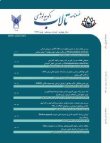Heavy metal contamination in surface sediments of four important rivers leading to the Caspian Sea
Author(s):
Article Type:
Research/Original Article (دارای رتبه معتبر)
Abstract:
Heavy metals tend to be adsorbed and accumulated in sediments as opposed to water or suspended solids. Sediments and biota bodis can act as a final sink for heavy metals in the aquatic environments. They accumulate through the food chain posing potential biological and ecological risks. Therefore, research on the heavy metal concentrations in aquatic ecosystems can help to protect human health and reduce the risks of heavy metal contamination. In this study, the contamination of heavy metals (Fe, Zn, Mn, Cu, Ni, Pb, Cd and Co) in surface sediments (0–5 cm) from 16 stations within four river intertidal zones (Neka, Tajan, Siahrood and Talar) were sampled and analyzed for metal contamination assessment in summer 2016. Results show that the mean concentration (mg kg-1) of heavy metals in surface sediment samples followed the order; Fe (23300.00) >Zn (2028.87) >Mn (701.25) >Ni (36.77) >Pb (25.77) >Cu (19.62) >Co (18.62) >Cd (5.62). The mean concentration levels of the heavy metals Pb, Zn and Cd were more than mean background value. The statistical analyses showed that concentration of elements Fe, Mn, Co and Cu in the Siahrood River, Cd in Neka River and Zn in Tajan River is different (P<0.05). Application of contamination factor (Cf), potential ecological risk factor of individual metals (Er), enrichment factor (EF) and geo-accumulation index (Igeo) showed that the highest value of the above factors belongs to cadmium element. Also an assessment potential ecological risk index (RI), contamination degree (Cd) and pollution load index (PLI) suggests a considerable to very high ecological risk in Neka River. In addition to revealing potential ecological risks due to cadmium and other elements, our investigation markedly highlighted anthropogenic control over sediment quality deterioration and some immediate sediment quality management strategies are needed to remediate and control river bed contamination.
Keywords:
Language:
Persian
Published:
Journal of Wetland Ecobiology, Volume:11 Issue: 2, 2019
Pages:
67 to 82
magiran.com/p2005603
دانلود و مطالعه متن این مقاله با یکی از روشهای زیر امکان پذیر است:
اشتراک شخصی
با عضویت و پرداخت آنلاین حق اشتراک یکساله به مبلغ 1,390,000ريال میتوانید 70 عنوان مطلب دانلود کنید!
اشتراک سازمانی
به کتابخانه دانشگاه یا محل کار خود پیشنهاد کنید تا اشتراک سازمانی این پایگاه را برای دسترسی نامحدود همه کاربران به متن مطالب تهیه نمایند!
توجه!
- حق عضویت دریافتی صرف حمایت از نشریات عضو و نگهداری، تکمیل و توسعه مگیران میشود.
- پرداخت حق اشتراک و دانلود مقالات اجازه بازنشر آن در سایر رسانههای چاپی و دیجیتال را به کاربر نمیدهد.
In order to view content subscription is required
Personal subscription
Subscribe magiran.com for 70 € euros via PayPal and download 70 articles during a year.
Organization subscription
Please contact us to subscribe your university or library for unlimited access!



